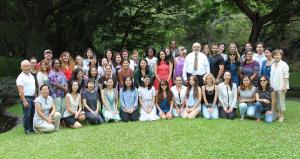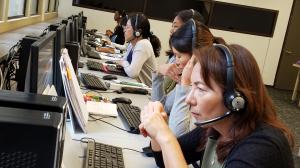High demand for interpreters met by intensive training through UH center
University of Hawaiʻi at Mānoa
Center for Interpretation & Translation Studies faculty and staff, and interpreter training participants.
The UH Center for Interpretation & Translation Studies (CITS) is hosting its 13th biennial Summer Intensive Interpreter Training (SIIT), with a record number 41 participants. Over the course of six weeks, the attendees from the United States, Europe, Africa and Asia are honing their skills in note-taking and consecutive and simultaneous interpreting, and learning from world-class teachers who draw on their unique experiences as interpreters themselves for organizations such as the United Nations and the European Union.
Communicating words, ideas and concepts across cultures is critically important and highly valued in today’s global society, so it should come as no surprise that translators and interpreters are in great demand. CITS, which is part of the UH Mānoa College of Languages, Linguistics & Literature, has highly skilled faculty, consultants and a vast network of experts that contribute to its curriculum and knowledge base.
CITS Director Lucia Aranda, a professor of Spanish in the Department of Languages and Literatures of Europe and the Americas, has extensive experience in translation and interpretation.
The word “intensive” is an appropriate descriptor for CITS’ hallmark program. After this summer’s concentrated instruction and practice in Chinese, Japanese, Korean, Spanish and French, participants’ interpreting skills are dramatically improved.
Here is what some of them shared about their personal experience that prompted their attendance:
Andrés Espinal (Spanish) from Colombia:
Referring to this year’s faculty (United Nations interpreter James Nolan and interpreter for the European Parliament and Commission, Corinne Imhauser), “When I saw the quality of the people who will train us here, that convinced me that this is for real, this is serious.”
Emiko Toriyama (Japanese) from Japan:
Interpreters often have to deal with surprises, like an ambassador who was scheduled to speak for a few minutes, but spoke for half an hour, which is a painfully long time for consecutive interpreting. “I was so concentrated on what the ambassador was saying, to make sure I interpreted everything correctly, that I didn’t even notice that an ambulance came and took a girl who fainted in the audience.”
Ekereobong Michael-Akuboh (French) from Nigeria:
- Why SIIT? – “I’ve been looking to train formally.” Ekereobong has a master’s degree in translation, but it involved mostly theory and only limited exposure to consecutive and simultaneous interpreting. The short and intensive emphasis drew her to the program. “It was very hard for my employer to release me for a longer period of time.”
- “I’m getting feedback that I’ve never really gotten anywhere before in my career.”
Summer Intensive Interpreter Training runs from July 3 to August 11.
(Full caption for group photo) Center for Interpretation & Translation Studies faculty and staff, and the class of the 13th biennial Summer Intensive Interpreter Training.
For more information, visit: http://cits.hawaii.edu/

